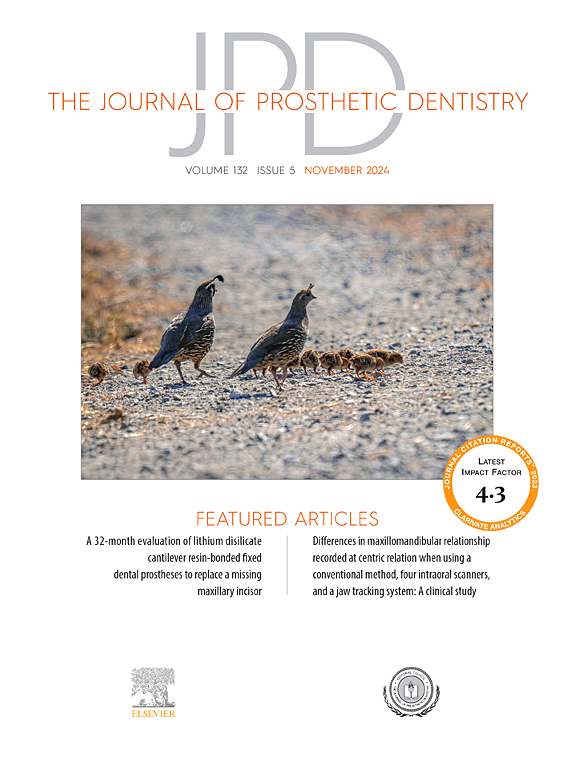摘要
问题陈述:与其他制造方法相比,快速原型或三维(3D)打印材料可提高临床效率。目的:本体外研究旨在评估不同聚合方法和时间对 3D 打印树脂(OnX;SprintRay)的抗弯强度、微硬度和颜色稳定性的影响:共 3D 打印了 40 个圆盘(Ø10×2 毫米)和 40 个条形(10×2×2 毫米),清洗后根据聚合方案分成 4 组(n=10):VALO Grand 光聚合装置聚合 40 秒和 120 秒(VG40s 和 VG120s),ProCure 2 聚合室聚合 1 个和 2 个周期(PC×1 和 PC×2)。将棒材在 37 °C 的蒸馏水中储存 24 小时,然后用万能试验机进行三点弯曲试验,试验机的跨度为 8 毫米,以 0.5 毫米/分钟的速度向下运动,直至断裂。用研磨盘对磁盘进行抛光。颜色稳定性的评估包括聚合后(基线)、在 37 °C 黑暗干燥环境中储存 1 天和 7 天后,以及在 60 °C 去离子水中人工老化 3 天后。b* 值用于计算人工老化 3 天后的黄移/Δb* 值。用努氏压头对暗干储存 7 天后的显微硬度进行评估。使用 Levene 检验评估数据的均匀性,使用 Shapiro-Wilk 检验评估数据的正态性。双向方差分析(弯曲强度、显微硬度和 Δb* 测试)和三向重复测量方差分析(颜色稳定性测试)均采用 Tukey HSD 后检验(所有测试均采用 α=.05):在弯曲强度方面,聚合单元(PVG40s.在颜色稳定性方面,聚合单元(P=.009)、时间(PVG40s=VG120s.聚合单元(PConclusions:使用 VG120s 聚合的树脂在显微硬度、抗弯强度和颜色稳定性方面的结果与 PC 相似或更好,同时显著缩短了后聚合时间。用 PC×2 聚合的试样显微硬度最低。过度延长聚合时间可能会损害 3D 打印部件的性能。Statement of problem: Fast prototyped, or 3-dimensionally (3D) printed, materials enhance clinical efficiency when compared with other manufacturing methods. Nevertheless, standardization and information regarding the influence of different postprocessing protocols on the final physical and mechanical properties of 3D printed parts is lacking.
Purpose: The purpose of this in vitro study was to evaluate the effect of different polymerization methods and times on the flexural strength, microhardness, and color stability of a 3D printed resin (OnX; SprintRay).
Material and methods: A total of 40 disks (Ø10×2 mm) and 40 bars (10×2×2 mm) were 3D printed, washed, and subdivided into 4 groups (n=10) according to the polymerization protocol: VALO Grand light polymerization unit for 40 and 120 seconds (VG40s andVG120s) and ProCure 2 polymerization chamber for 1 and 2 cycles (PC×1 and PC×2). The bars were stored in distilled water at 37 °C for 24 hours, and a 3-point bend test was performed with a universal testing machine with an 8-mm span and a downward movement at a rate of 0.5 mm/minute until fracture. The disks were polished with abrasive disks. Color stability was assessed after polymerization (baseline), after 1 and 7 days in dark, dry storage at 37 °C, and after 3 days of artificial aging in deionized water at 60 °C. Values of b* were used to calculate yellow shift/Δb* values after 3 days of artificial aging. Microhardness after 7 days in dark, dry storage was assessed with a Knoop indenter. The data were assessed for homogeneity using the Levene test and for normality using the Shapiro-Wilk test. Two-way ANOVA (flexural strength, microhardness, and Δb* tests) and 3-way repeated-measures ANOVA (color stability test) were followed by the Tukey HSD post hoc test (α=.05 for all tests).
Results: For microhardness, the polymerization unit (P<.001), polymerization cycles (P=.003), and interaction between both factors (P=.005) were significantly different, with VG40s=VG120s>PC×1>PC×2. For flexural strength, the polymerization unit (P<.001), polymerization cycles (P<.001), and interaction between both factors (P<.001) were significantly different, with VG120s=PC×1=PC×2>VG40s. For color stability, the polymerization unit (P=.009), time (P<.001), and interaction between time and polymerization unit (P<.001) and time, polymerization unit, and cycle (P=.01) were significantly different. After 3 days of artificial aging, PC×1=PC×2>VG40s=VG120s. Significantly different Δb* was found for polymerization unit (P<.001) and polymerization cycles (P=.002), with VG120s Conclusions: Resins polymerized using VG120s produced similar or better microhardness, flexural strength, and color stability results than PC while significantly decreasing the postpolymerization time. Specimens polymerized with PC×2 showed the lowest microhardness. Excessively increased polymerization time may jeopardize the properties of 3D printed parts.

 求助内容:
求助内容: 应助结果提醒方式:
应助结果提醒方式:


